The College of Arts & Sciences has announced a new senior-level position to enhance and support its long-standing commitment to education innovation. Peter Lepage, professor of physics and former dean of the College of Arts & Sciences, will serve as the College’s first Director of Education Innovation.
“Peter is a real leader in educational excellence both within the college and nationally. He helped to initiate the Active Learning Initiative (ALI), and we are fortunate that he will be at the helm of the college’s ongoing efforts to expand our engaged learning strategies,” said Gretchen Ritter, the Harold Tanner Dean of Arts & Sciences. “We have fabulous faculty in the college and we look forward to finding new ways to enhance their success as educators both inside and outside the classroom.”
Lepage brings a long-standing interest in innovative pedagogy to his new position. He served as co-chair of the working group for the President’s Council of Advisors on Science and Technology (PCAST), which in 2012 produced the often-cited report, “Engage To Excel: Producing One Million Additional College Graduates with Degrees in Science, Technology, Engineering, and Mathematics.” He currently serves on the Technical Advisory Committee for the Association of American Universities’ Undergraduate STEM Education Initiative, and is Vice-Chair of the National Science Board’s Committee on Education and Human Resources. He was also recently honored as the winner of the prestigious Sakurai Prize in physics.
The college’s engaged learning initiatives have strong alumni support. The ALI five-year pilot project, for example, is funded by Alex and Laura Hanson, both Class of 1987.
“We have many donors who are passionate about the well-being of students and excited about initiatives around student learning,” says Lepage. “Thanks to their support, we have resources to initiate broad, innovative projects in the college. Part of my job will be to help departments scale up from the individual efforts of professors who have initiated new models of teaching to a department-wide curriculum of engaged learning.”
Assistant Professor Andrew Hicks with students in Music 1101: Elements of Music
Many of the college’s 700+ instructors already use active learning techniques. Assistant Professor Andrew Hicks’ Elements of Music class features a broad collaboration among faculty across the music department and hands-on, interactive opportunities for students, such as experimentation with instruments, an in-class sound art installation, and collaborative performance and dance. Students in the Ethics of Eating philosophy course, taught by Associate Professor Andrew Chignell and Assistant Professor Will Starr, examined food issues in the real world with hands-on planning and preparation of a locally-sourced feast. (The course has since become a Cornell MOOC.)
“Students learn best when they’re actively engaged, so each year I try something new,” says Suzanne Mettler, the Clinton Rossiter Professor of American Institutions. Last year she added iClickers, an audience response system, to her Introduction to American Government and Politics class, which already features an engaged learning exercise that simulates the budget process in the real U.S. Senate. The iClickers enabled Mettler to assess how much students understood in their assigned reading.
Professor Suzanne Mettler working with students
Emerging technologies offer tremendous possibilities in all disciplines, Lepage notes. “The iClicker, for example, is a powerful tool for the kind of humanities and social science questions with no clear-cut answers. Audience response technologies enable all students, even in a large class, to participate and contribute to class discussions.”
"Going into it I didn't know what to expect; letting go of the traditional lecture format felt really disorienting,” says associate professor of physics Julia Thom-Levy about her experience teaching an ALI course. “But then I started the first active learning exercise and suddenly the lecture hall was buzzing with discussions! That's when I knew it would work."
One misconception about engaged learning models is that they are meant to replace lectures, and that is incorrect, says Lepage. “Active learning models use short lectures in strategic ways, teaching according to how people learn most effectively. Studies show that student-student discussion followed by a lecture results in the best learning. Exercising your knowledge by talking to someone is hugely beneficial in cementing knowledge. ”
Gabriela Balbín ’15 says that the discussions in Mettler’s course made a difference when studying for finals. “It’s another way to trigger your memory of that day and what you learned in class. I think it really helps.”
Measured results from the ALI courses at Cornell prove the point. There have been significant improvements in student learning, as reflected by their performance on exam questions. “It’s impressive what the faculty have done,” says Lepage.
Student feedback from active learning classes has been overwhelmingly positive. After taking Introduction to Neuroscience with Ron Harris-Warrick, William T. Keeton Professor of Biological Sciences, a student wrote, “I now understand what it is like to BE a scientist.” Another said that the class “pushed me to really think instead of memorizing.”
Linda B. Glaser is a staff writer for the College of Arts & Sciences






